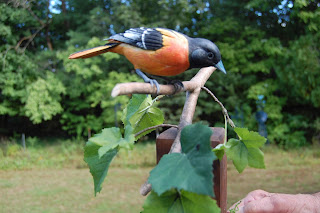Scott Ulrich is working to create a
drug that disrupts the communication system that bacteria use to coordinate
disease-causing behaviors, and he was just awarded a major grant from the
National Institutes of Health to help him do it.
The Ithaca College associate
professor of chemistry will use the three-year $360,000 grant to design complex
molecules that will block the communication system known as quorum sensing.
“Bacteria communicate with each
other using chemical signals,” explained Ulrich. “When their signaling is
engaged, the population undertakes a new behavior. Sometimes that behavior
causes diseases in people. If we can block that signaling, then the behaviors
the signaling controls would also be suppressed. I want to accomplish that by creating
a drug-like inhibitor.”
Ulrich has been studying quorum
sensing for more than a decade. In his previous work, he and two students – in
collaboration with scientists from Princeton University – created a drug that
blocked the bacterial signal detector, essentially making the bacteria deaf so
they did not know that other bacteria were trying to communicate. Now he is
attempting to render the bacteria mute by preventing their ability to generate
a communication signal in the first place.
“This is a very hard thing to do.
Few other chemists have found such drugs,” he said. “Several IC students and I
have worked without much success since 2010 to set up the biochemical system
needed to find such compounds. I was ready to give up.”
Then came Erin Higgins, a
biochemistry student who insisted on working on the project last year despite
Ulrich’s repeated advice not to.
“She re-created the signal
generation system in a test tube using purified bacterial proteins, and it
actually makes the signaling molecule,” he said. “Now we can add candidate drugs
to the system to see if they block the process of making the signal. It’s the
most impressive work I’ve ever seen an undergraduate do. Her results led
directly to the grant and serve as the foundation for the work my students and
I will do for many years.”
There is still plenty of difficult
work ahead. Ulrich said that the enzyme that produces the communication signal
provides clues to the kind of organic structures that might block the system
from working. And he already has some designs in mind. So his students will
spend the next three years building as many different kinds of molecules as they
can and testing to see which ones are most successful at disrupting the
bacteria from communicating.
“The ideal outcome would be to find
a molecule that blocks the quorum sensing signal production without requiring a
large dosage,” Ulrich said. “Generally, more potent compounds work better
against the intended target and are safer.”
Assuming he succeeds at building an
effective molecule, his next step would be to work with his Princeton
collaborators to test the molecule to see if it inhibits the disease-causing
behavior.
“That’s the outcome we’re looking
for,” he said.



